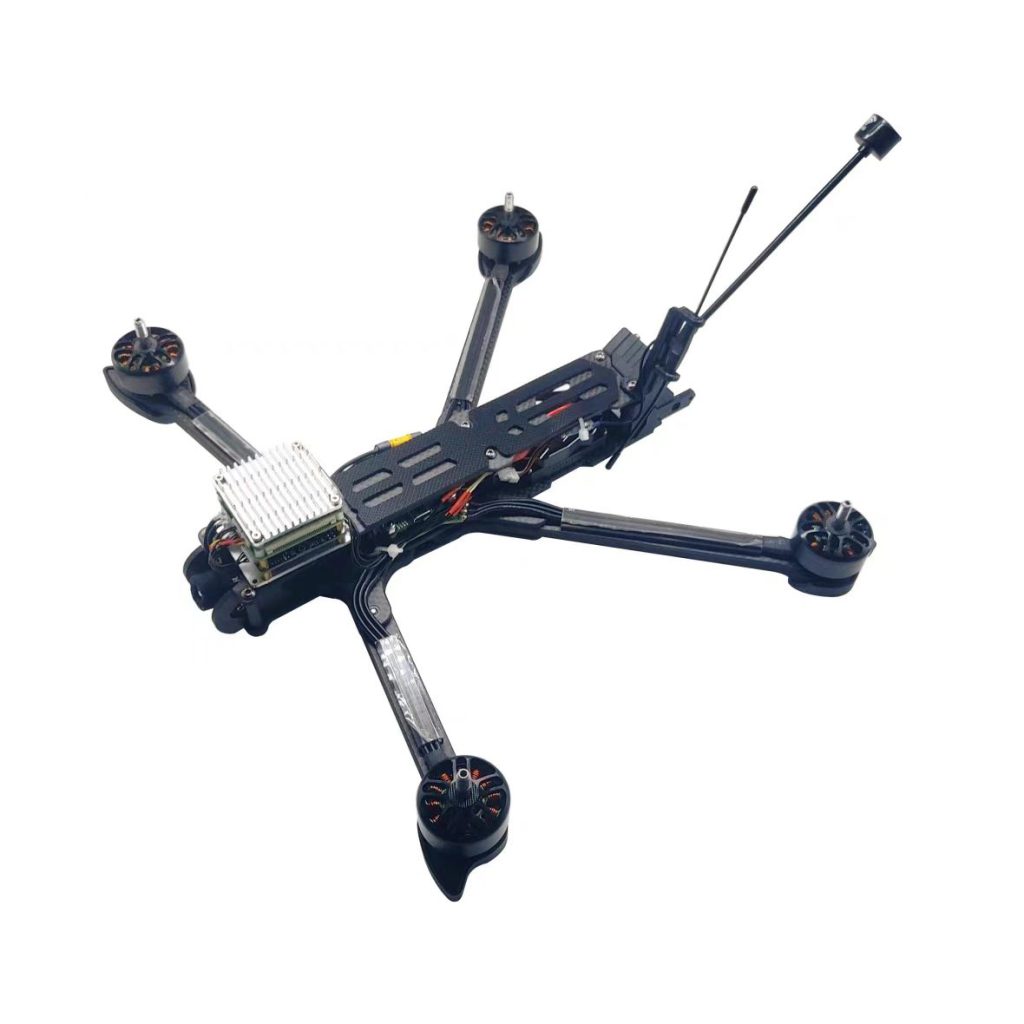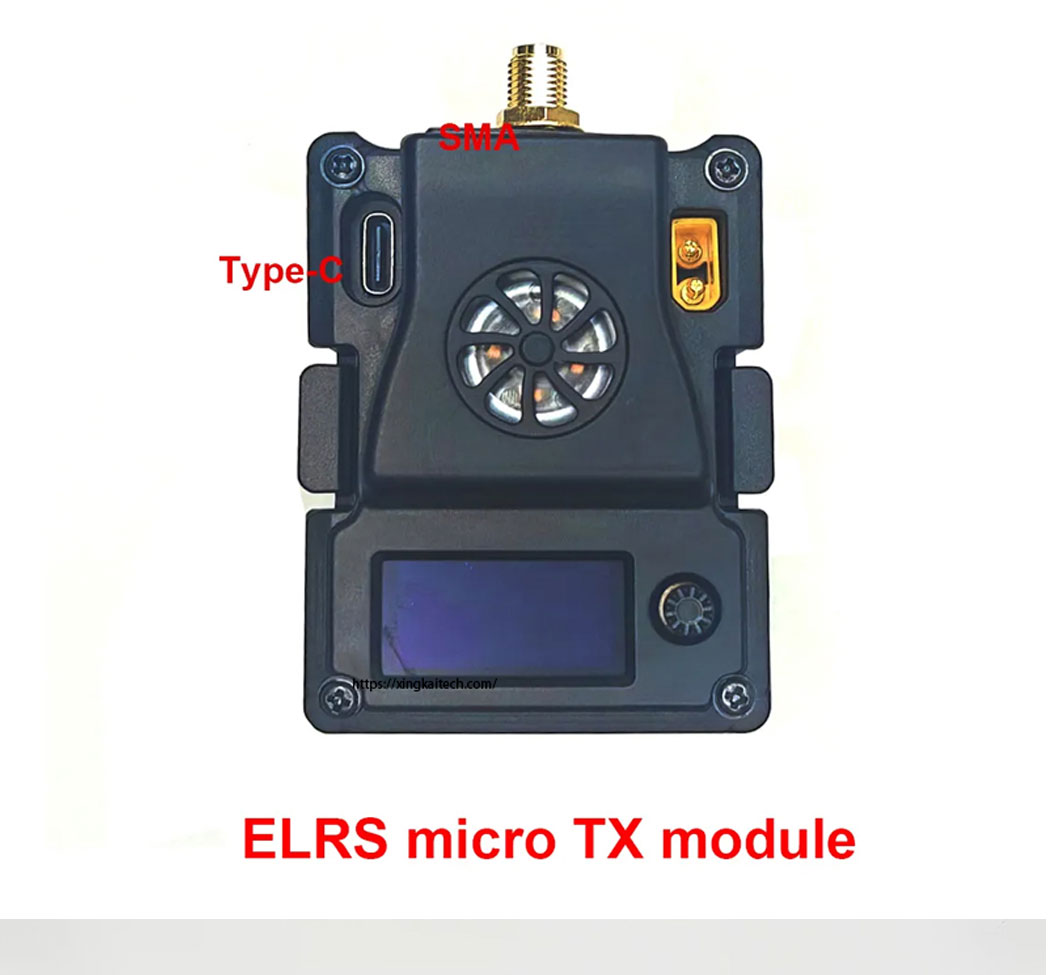Discovering the Orthogonal Frequency-Division Multiplexing (OFDM)

Orthogonal frequency-division multiplexing (OFDM) is a communication technology that uses orthogonal frequency-division signals. OFDM is often used in digital radio, Mondiale, digital audio broadcasting, and satellite radio. OFDM allows more data to send over the same bandwidth as single-frequency transmissions. It can improve the signal quality and enable more channels to transmit over broadcast frequencies.
And OFDM technology improves the transmission of data.
OFDM is a wireless technology that divides the RF spectrum into many small, overlapping channels. This technique, known to call quadrature modulation
This allows for more data to send over a single transmission channel. And it can improve the reliability and performance of wireless networks.
This article will discuss some of the uses of OFDM and how it can benefit your business. We will also highlight some challenges you may face when implementing OFDM and offer tips on overcoming them.
What is OFDM?
Orthogonal frequency-division multiplexing (OFDM) is a modulation technique that uses orthogonal frequency components to modulate data signals.
OFDM is similar in principle to time-division multiplexing (TDM), but it uses multiple carrier frequencies instead of time slots. The advantage of OFDM is that it can provide greater capacity than TDM systems over long distances.
Applications of OFDM
There is a lot of modulation in orthogonal frequency division multiplexing (OFDM). OFDM is used in various applications, including cellular systems (3GLTE, WiMAX), wireless local area networks (LANs), digital audio radio, underwater communication, and optical light modulation.
Applications of OFDM include broadband wireless access, digital television services, and mobile communications. In broadband wireless access, OFDM provides multiplexing and frequency reuse capability over wide bandwidths. In digital television services, OFDM also offers high-quality video over broadcast channels. And in mobile communications, we use OFDM to provide multiple channels over a single bandwidth.
How does OFDM Work?
OFDM is a modulation scheme that uses orthogonal frequency-division multiplexing to spread data over multiple radio frequencies. Recently many companies have used it in wireless communications, such as Wi-Fi and Bluetooth, because it offers greater capacity than traditional transmission methods.
To understand how OFDM works, first imagine a radio wave. Radio waves are electric and magnetic fields that travel through the air as waves. The electric field oscillates at a specific frequency, while the magnetic field vibrates at a different frequency.
When two radios communicate, they send out radio waves at the same frequency. If the radios are far apart, the waves will overlap, and no information will be sent. But if the radios are close, they can send their waves at different frequencies so that only one wave reaches the other.
You can see this happen in an experiment called a crystal set. If you put two radios next to each other and turn them on, you’ll hear one station playing music while the other station talks. The two stations send their radio waves at different frequencies, so they don’t interfere with each other.
What are the benefits of using OFDM?
The main benefits of using OFDM are that it is a more efficient way to transmit data and can support a more significant number of users in a given area. Additionally, OFDM can be more resistant to interference than other communication methods.
OFDM has many benefits:
1. OFDM can transmit more data over the same spectrum as traditional methods.
2. OFDM is immune to multipath distortion, which reduces the quality of voice and video transmissions.
3. OFDM can reduce interference from other wireless devices close to the transmitter.
4. OFDM is less prone to breakage and errors than other modulation techniques
Advantages of OFDM over other wireless technologies
Orthogonal frequency-division multiplexing (OFDM) is a wireless technology that uses orthogonal signals to improve communication reliability. OFDM can be used in several applications, such as satellite communications, terrestrial mobile communications, and broadband internet service.
The advantages of OFDM over other wireless technologies include the following:
1. OFDM is more reliable than other wireless technologies because it uses orthogonal signals. This allows the system to tolerate more noise and interference than conventional systems.
2. OFDM offers high data capacity due to its use of multiple channels. This allows for greater throughput in large networks and better performance in dense deployments.
3. OFDM is less impactful on the environment than other wireless technologies. It has lower energy requirements and less environmental impact when installed.
OUR FPV Accessories
ELRS 2.5W TX High frequency head For FPV Drone
- 1.ELRS-2.5W-TX The high-frequency head is a new generation of remote controlwireless system developed based on the open-source project ExpressLRS. The ELRS systemhas the characteristics of long remote control distance, stable connection, low latency,high refresh rate, and flexible configuratio.
- 2.By default, the ELRS-2.5W-TX high-frequency head only accepts signals from the Crossfire Serial Data Protocol (CRSF). The high-frequency head interface of the remote control needs to support CRSF signal output. The following takes the OpenTX remote control system as an example to illustrate how to configure the remote control to output CRSF signals and use the LUA script to control the ELRS high-frequency head

AI Guidance Module New Product FPV
- This module is an intelligent system that integrates advanced computer vision technology, designed specifically for various monitoring and target following requirements
- It ends Combining core functions such as anomaly target detection, mobile robot visual tracking, smart home security monitoring, and image processing in the field of education, Provide comprehensive intelligent solutions.
AI Driver Target Tracking Module For FPV Drone
- 1.Intelligent tracking: Equipped with an intelligent tracker, the advanced target tracking algorithm is used to accurately lock the target in the stationary/moving state, which solves the problem of tracking the target in the high-speed movement and complex environment of the traditional UAV.
- 2.Intelligent guidance: The guidance rate technology integrated with terminal guidance can guide the aircraft to the target by measuring the relative position of the target and the aircraft.

FPV Fiber Optic Video Data Module
- Fiber optic diagram module, capable of flying 2km/3km/5km/10km/15km/19km, newly developed long-distance ultra light version. FPV unmanned aerial vehicles fly easily and transmit over long distances
- Products are diverse and compatible
- Signaltransmission connectors canbe customized
Fiber Optic Image Data Module Transmission to Ground Receiver Optical Link Sky Endpoint
- Fiber optic figure module adopts fiber optic as the transmission medium, fast transmissionspeed, strong stability, can meet the demand of large data transmission, not subject to the influenceof electromagnetic interference, to prevent eavesdropping and eavesdropping,can support up to 20km of wired signal transmission.
- The complexity of the city’s official website, short-wave communicationis dificult to cover all the scenes, the use of fiber-optic communication, high-speed andstable data transmission, anti-jamming ability, long-distance communicationwith low loss,lightweight and easy to carry, to improve the efficiency and safety ofpipeline maintenance.
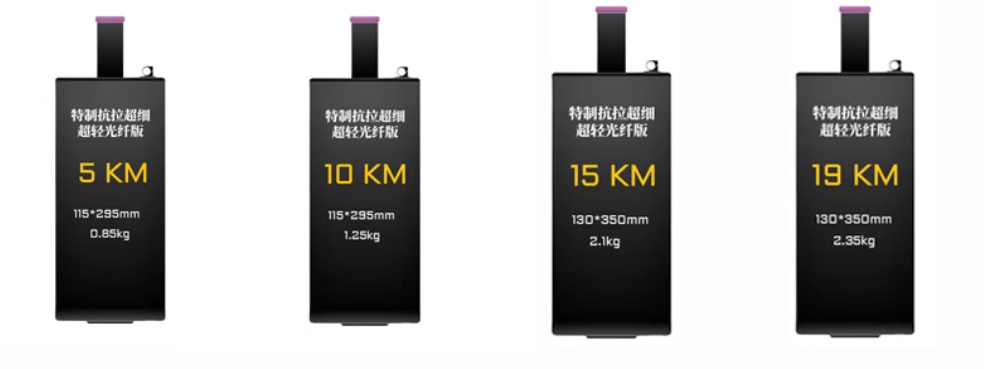
FPV Optical Fiber Video Date Module Urltra-Light
- Fiber optic diagram module, capable of flying 5km/10km/15km/19km, newly developed long-distance ultra light version. FPV unmanned aerial vehicles fly easily and transmit over long distances
- Products are diverse and compatible
- Signaltransmission connectors canbe customized
Optical Fiber FPV Drone Kit 0.5mm 0.6mm 2km 3km 5km 10km 15km 20km internal wiring UAV Fibre Optic Image Data Module ABS Optical Communication RC
- Outer diameter: 0.26 0.3 0.35 mm
- Attenuation coefficient: attenuation under the wavelength of optical signal 1310nm is less than 0.35 dB/km, and under the wavelength of optical signal 1550nm, attenuation is less than 0.21 dB/km.
- Tensile strength: >60N (ordinary) + 120 N (high-end).
- Bending radius: 5 mm.
- Density: slightly negative buoyancy.
- Maximum laying distance: >20 km.

FPV Drone Optical Fiber Kit Fiber 5km 10km 20km 30km UAV Fibre Optic Video Data Module
- Fiber optic interface: FCinterface
- Fiber Type: Singlemode-Single
- Product Interface: GH1.25 Video format: NTSC/PAL/SECAM
- Data direction: bidirectional
- Data format: TTL/S.BUS Speed: 0~1Mbps
- Wavelength single mode: 1310(9/125μm)+1550
- Transmission distance: single mode fiber 3-30km

ELRS 433MHz Receiver 360mHz 530MHz ExpressLRS Receiver
- The frequency should be the same, the same is 2.4G or the same433Mhz, etc
- There are three types of firmware version certification standards: AU, EU, and FCC. To be consistent, for example, the high-frequency head flashes the FCC 3.0.0 firmware, then the receiver should also flash the FCC 3.0.0 firmware or above;
- None of them have a linking password, or they all have the same password.
ELRS 433TX Transmitter High Frequency Head
- BelinRC ELRS-433-TX The high-frequency head is a new generation of remote control wireless system developed based on the open-source project ExpressLRS. The ELRS system has the characteristics of long remote control distance, stable connection, low latency, high refresh rate, and flexible configuration.


ExpressLRS 915MHz Nano RX Long Range Receive
- 1,The frequency should be the same, the same is 2.4G or the same 915Mhz, etc
- 2,There are three types of firmware version certification standards: AU, EU, and FCC. To be consistent, for example, the high-frequency head flashes the FCC 3.0.0 firmware, then the receiver should also flash the FCC 3.0.0 firmware or above;
- 3,None of them have a linking password, or they all have the same password.
ELRS 900MHz VTX EMAX Link ExpressLRS Micro TX Module
- Frequency Band: (900MHz version/720-1020Mhz optional)
- Output power: 100mW/250mW/500mW/1000mW/(2000mW optional)
- Refresh rate: 25Hz/50Hz/100Hz/200Hz
- Input Voltage: 5-12V(2S)
- Main control IC: ESP32+SX1276, backpack chip ESP8285
- By default, the ELRS-900-TX high-frequency head only accepts signals from the Crossfire Serial Data Protocol (CRSF). The high-frequency head interface of the remote control needs to support CRSF signal output. The following takes the OpenTX remote control system as an example to illustrate how to configure the remote control to output CRSF signals and use the LUA script to control the ELRS high-frequency head。

ELRS 2.4G Receiver Sbus Receiver Radio Transmitter
- This receiver can be used to frequency different brands of high frequency heads. The ELRS project is an open source project, so as long as the high-frequency headers of the ELRS protocol are used, regardless of the brand, they can be linked to each other, but three conditions must be met:
- 1.The frequency should be the same, the same is 2.4G or the same915Mhz, etc
- 2.There are three types of firmware version certification standards: AU, EU, and FCC. To be consistent, for example, the high-frequency head flashes the FCC 3.0.0 firmware, then the receiver should also flash the FCC 3.0.0 firmware or above;
- 3.None of them have a linking password, or they all have the same password.
4.9-6.1G 3W Image Transmission Equipped with 15cm Antenna
- *It supports 4.9G to 6.1G broadband operation, and customers can choose freely.
- *High-efficiency DC/DC power supply supports 7-36V; Wide range of voltage inputs.
- * Push-button/TBS control to quickly change CH and power.
- *Dual-core bi-amp design, mutual backup, better stability.
- * The special design does not connect the antenna and does not burn the power amplifier, so as to prevent the product from being burned by forgetting to plug in the antenna for a short time.
- *Automotive-grade temperature range RF crystal for more frequency stability.
- *Selected high-strength aluminum alloy CNC shell plus external large-size turbofan, active heat dissipation, enhanced power, stable transmission.

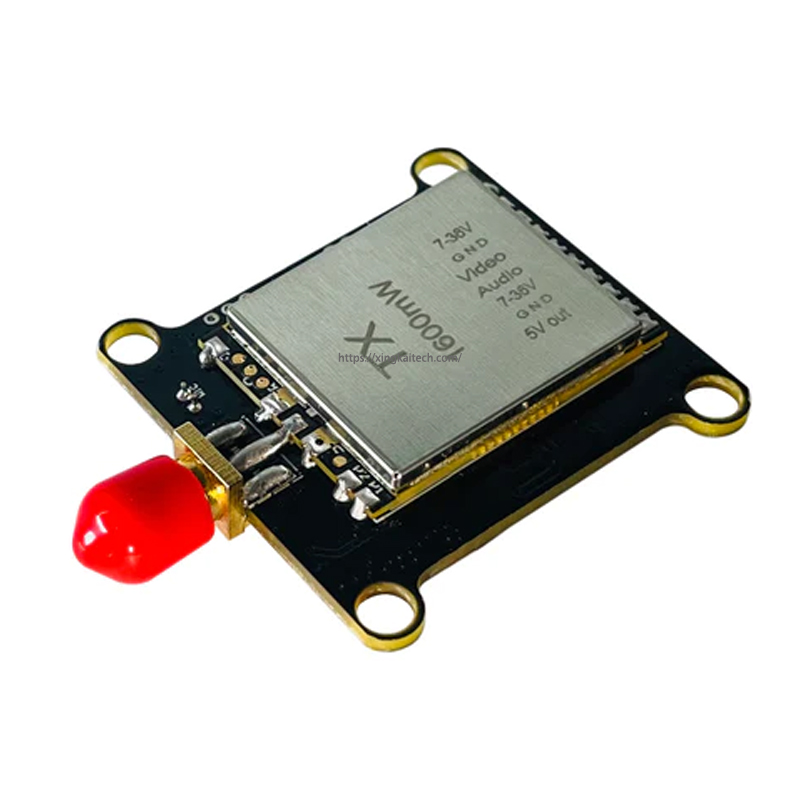
1.2G 1600mW FPV VTX Long Range Video Transmitter
- Input Voltage: 7-36V DC;2-8S
- Output Voltage: 5V 1A
- 12V Input Current: 80mA@Pitmode, 190mA@25mW, 230mA@200mW,
- 530mA@1600mW
- Channels: 9CH (1060MHz-1380MHz)
- Power: PIT/25/200/1600/mW
- Antenna connector: SMA
- Dimensions: 45.5*35.6*11.5 mm; 30.5*30.5mm(hole)
- Weight: 22g
1.2G/1.3G 2W FPV VTX Long Range Video Transmitter
- Item: 1.2G VTX 2000mW
- Input Voltage: 7-36V DC;2-8S
- Output Voltage: 5V 1A
- 12V Input Current: 235mA@Pitmode, 360mA@25mW, 880mA@2000mW,
- Channels: 9CH (1060MHz-1380MHz)
- Power: PIT/25/2000/mW
- Antenna connector: MMCX
- Smart Audio: IRC-tramp
- Shell Material: Aluminum
- Dimensions: 37.7*36.1*11 mm; 30.5*30.5mm(hole)
- Weight: 16g


1.2G 800mW FPV VTX Long Range Video Transmitter 1.2GHz – 1.3GHz for FPV Drones
- Item: 1.2G VTX 800mW
- Input Voltage: 7-36V DC;2-8S
- Output Voltage: 5V 1A
- 12V Input Current: 80mA@Pitmode, 170mA@25mW, 210mA@200mW, 380mA@800mW
- Channels: 9CH (1060MHz-1380MHz)
- Power: PIT/25/200/800/mW
- Antenna connector: SMA
- Dimensions: 45.5*35.6*11.5 mm; 30.5*30.5mm(hole)
- Weight: 21g
4.9G 1.6W FPV VTX Long Range Video Transmitter
- Item: 4.9G/1.6W FPV VTX
- Input Voltage: 7-36V DC;2-8S
- Output Voltage: 5V 1A
- 12V Input Current: 180mA@Pitmode, 200mA@25mW, 330mA@400mW,
- 410mA@800mW, 620mA@1600mW
- Channels: 8CH (4990MHz-5200MHz)
- Power: PIT/25/400/800/1600 mW
- Antenna connector: MMCX
- Smart Audio: IRC-tramp
- Shell Material: Aluminum
- Dimensions: 37.7*36.1*9.5 mm; 30.5*30.5mm(hole)
- Weight: 15.8g


5.8G 5.8GHz 3W Video Transmitter VTX
- 1. 48CH 5.8G frequency range: (A.B.E.F.R.L; 5362MHz-5945MHz);
- 3. Input voltage: DC 7V-36V, supporting 2-8S battery input
- 4. Antenna connector: MMCX
- 5. Smart audio: IRC Tramp
- 6. Heat-dissipating method: aluminum alloy heat sink&fan
- 7. Hole spacing: 30.5mm*30.5mm /ø3.15mm
- 8. Dimension: 37.7mm*36.1mm*11mm
- 9. Weight: 16g
5.8G 1.6W FPV VTX Long Range Video Transmitter
- Item: 5.8G/1.6W FPV VTX
- Input Voltage: 7-36V DC;2-8S Output Voltage: 5V 1A
- 12V Input Current: 180mA@Pitmode, 200mA@25mW, 330mA@400mW,
- 410mA@800mW, 620mA@1600mW
- Channels: 48CH (A.B.E.F.R.L;5362MHz-5945MHz)
- Power: PIT/25/400/800/1600 mW
- Antenna connector: MMCX
- Smart Audio: IRC-tramp
- Shell Material: Aluminum
- Dimensions: 37.7*36.1*9.5 mm; 30.5*30.5mm(hole) Weight: 15.8g

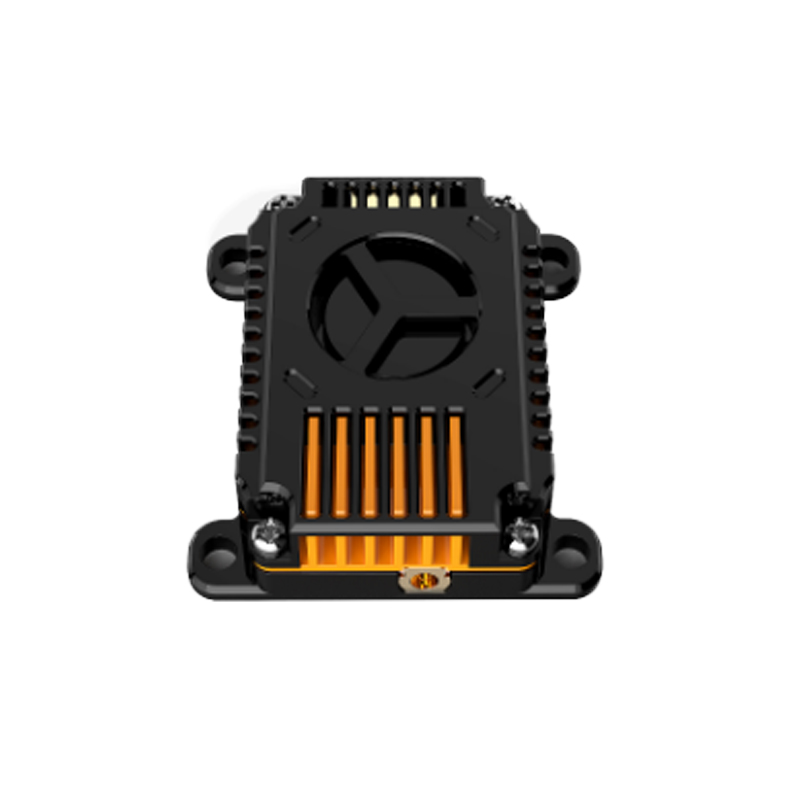
4000mW 5.8G Long Range FPV VTX Long Range Video Transmitter 48CH
- Item: 5.8G 4000mW FPV VTX
- Input Voltage: DC6-36V, 2-8S
- Output Voltage: DC5V, 1A
- 12V Input Current: 145mA@Pit-mode, 280mA@25mW, 950mA@4000mW
- Channels: 48CH(A.B.E.F.R.L; 5362MHz-5945MHz)
- Power: PIT/25/4000mW
- Antenna Connector: MMCX
- Smart Audio: IRC-tramp
- Shell Material: Aluminum
- Dimensions: 37.7*36.1*11mm; 30.5*30.5mm(hole)
- Weight: 16g
1.2G/1.3G Long Range FPV VRX With AV Out 9CH Video Receiver for RC Drone Goggles Monitor
- Item: 1.2G/1.3G FPV VRX
- Receiving frequency: 9CH (1050MHz to 1380MHz)
- Input voltage: DC 7-36V
- Current Consumption: (280±40)mA @5V
- Button control and LED indicators
- On board regulator output: 5V 1A RX
- Sensitivity: -95dBm
- Voltage Standing Wave Ratio: 2:1
- Demodulation System: FM/PLL ANT.
- Input Impedance: 50Ω, Typ.
- Video Output Impedance: 75Ω, Typ.
- Audio Subcarrier Frequency: 6.0MHz (AR) 6.5 MHz (AL)
- RF Connector: SMA
- Dimensions: 44mm (L)*27mm (W)*27mm (H)
- Weight: 20g ( w/o antanna)


1.2G/1.3G VRX Long Range FPV 9CH Video Receiver for 800D Pro FPV Goggle
- Receiving frequency: 9CH (1050MHz to 1380MHz)
- Input voltage:DC 5V
- Current consumption: (280±40) mA@5V
- Button control and LED indicators
- RX Sensitivity: -95dBm
- Voltage Standing Wave Ratio: 2:1
- Demodulation System: FM/PLL
- ANT. input impedance: 50Ω, Typ.
- Video Output impedance: 75Ω, Typ.
- Audio Subcarrier Frequency: 6.0MHz (AR) 6.5 MHz (AL)
- RF Connector: SMA
- Weight: 12g ( w/o antanna)
1.2G/1.3G VRX Long Range FPV 9CH Video Receiver for 800D Pro FPV Goggle
- Receiving frequency: 8CH (4990MHz to 5200MHz)
- Input voltage:DC 5V
- Current consumption: (380±40) mA@5V
- RX Sensitivity: -90dBm
- Voltage Standing Wave Ratio: 2:1
- Demodulation System: FM/PLL
- ANT. input impedance: 50Ω, Typ.
- Video Output impedance: 75Ω, Typ.
- Audio Ouput Frequency Range: 100Hz-20000Hz
- RF Connector: SMA
- Weight: 15.6g ( w/o antanna)
- Size: board 42.5mm (L)*27.7mm (W)*20mm (H)


5.8G FPV VRX Long range 40CH Video Receiver for 800D Pro FPV Goggles (include 4.9G)
- Receiving frequency: 40CH (5645MHz to 5945MHz)
- Input voltage:DC 5V
- Current consumption: (380±40) mA@5V
- RX Sensitivity: -90dBm
- Voltage Standing Wave Ratio: 2:1
- IF: 480MHz
- Demodulation System: FM/PLL
- ANT. input impedance: 50Ω, Typ.
- Video Output impedance: 75Ω, Typ.
- Audio Ouput Frequency Range: 100Hz-20000Hz
- RF Connector: SMA
- Weight: 15.4g ( w/o antanna)
- Size: board 42.5mm (L)*27.7mm (W)*20mm (H)
FPV Monitor 5.8G 40CH 3 Inch LCD 480×320 Auto Search
- Small size and light weight;
- Low power consumption, Working current 360~400mA;
- RaceBand 40 channel, Auto-Searching;
- 3.0 Inch 480*320 dot high brightness LCD screen;
- Built-in super sensitiveness 5.8GHz 40ch receiver, especially with RaceBand;
- Built-in 3.7V/800mAh high-capacity Li-ion polymer Battery;
- Universal USB charging interface;
- Real-time video return, Very low time-delay;
- Bilingual menu in support of Chinese and English;
- Support external video signal input;
- Support AV signal output (Connect external DVR);
- It can be used as a receiver for “DJI” and other video glasses. With interest screen function


5.8G FPV Monitor with DVR 40CH 4.3 Inch LCD Display
- Low power consumption
- One-click automatic channel search
- Can record anytime and anywhere
- Dual antenna reception can make the signal more stable 4.3 inch 800*480 high-definition bright screen
- Built-in super sensitive 5.8G 40 channel receiver
- Built-in 3.7V/1200mAh high-capacity polymer lithium battery
- Universal usb charging interface
- Real-time video, low latency
- Chinese and English bilingual menu
- Support audio and video input
- Expenditure audio output (headphones can be connected)
- Support 5-23V wide voltage charging
5 Inch 5.8GHz 40CH Diversity Receiver FPV Monitor
- 5.8G 40CH true diversity receiver
- Ultra-high luminance,800x480px HD screen
- One-Key-Auto search,simple operation
- 360 degree all-view HD display
- Three video recording modes: DVR(VGA/D1/HD)
- Built-in 4000mAh high capacity battery
- Support DC 5-23V wide voltage
- Support 2-6S lipo battery,very suitable for long time flight
- Support up to 64G TF card
- Support video replay
- Support eight languages


5.8G 40CH 7 Inch FPV Monitor LCD Screen
- Built-in Dual Receiver Automatically for best reception Automatic Antenna Switching
- Dual buffered AV outputs
- Not affect by 2.4GHz R/C Radios
- AV Receiver with Diversity inputs
- Small, light weight, durable
- 5 bandss and total 40 Channels
- Built-in battery , easy to carry and outdoor use
- A key to automatic signal search,Simple operation
- Work status OSD display:Always be aware of the device working condition.
- Notice: It can’t receive 2 different channels at the same time
5.8G 40CH 7 Inch Raceband FPV Monitor 800×480 With DVR
- With DVR function
- Built-in Dual Receiver for best reception
- Dual buffered AV outputs
- Not affect by 2.4GHz R/C Radios
- AV Receiver with Diversity inputs
- Small, light weight, durable
- 5 Bands and total 40 Channels
- Built-in battery , easy to carry and outdoor use
- A key to automatic signal search,Simple operation
- Work status OSD display:Always be aware of the device working condition.
- Notice: It can’t receive 2 different channels at the same time


3-inch 5.8GHz 40CH FPV Goggle First Person View Glass VR009 Black
- Small size and light weight;
- Low power consumption, Working current 300~330mA;
- Double antenna reception to make the signal more stable;
- RaceBand 40 channel, Auto-Searching;
- 3.0 Inch 480*320 dot high brightness LCD screen;
- Built-in super sensitiveness 5.8GHz 40ch receiver, especially with RaceBand;
- Built-in 3.7V/1200mAh high-capacity Li-ion polymer Battery;
- Universal USB charging interface;
- Real-time video return, Very low time-delay;
- Bilingual menu in support of Chinese and English;
- Support external video signal input;
- Support AV signal output (Connect external DVR);
- Power adapter: DC5V/1A (USB interface)
- Antenna: 2 X RP-SMA male
5.8G FPV Goggle 4.3 Inch Double Antenna FPV Glasses 008D
- Separable design, 4.3 inch screen can be used as small monitor on radio controller or with tripod
- High brightness 4.3 inch LCD specially tuned for FPV racing or Model airplane
- Built-in super sensitiveness 5.8GHz 40ch receiver, especially with RaceBand.
- Come with advanced auto-searching function ad show your the working frequency on screen
- Built-in 3.7V/2000mA battery ,each full charge revive around 2 hours working time
- Ergonomic design fit your faces
- 92% transparent lens adopted ,no distort,no blur on the adage of screen;
- Light weight 375g with 2hr 2000mAh battery, RTF for any scale, racing, Model airplane game
- 4.3 inch 480*320px HD high brightness LCD


5.8G FPV Goggle 4.3 Inch Double Antenna FPV Glasses 008D Pro
- 4.3-inch 800×480-dot high-brightness LCD screen; with DVR, you can record video anytime, anywhere
- Built-in ultra-sensitive 5.8GHz 40ch receiver, especially RaceBand
- Built-in 3.7V/2000mAh high-capacity lithium-ion polymer battery; Universal USB charging interface
- Dual antenna reception, the signal is more stable; Automatic search, support one-key search frequency
- Real-time video backhaul with extremely low latency; Support Chinese and English bilingual menu; Support external video signal input; Support audio signal output (can connect external headphones)
- Specifications:
- Product size: 155 * 144 * 113mm
- Product weight: 300g
- Working current: 400mA
- Receiving frequency: 5645-5945MHz
5.8G 5-inch FPV Drone Goggle 800D
- With DVR, you can record videos anytime and anywhere;
- Low power consumption;
- Double antenna reception to make the signal more stable;
- Auto-Searching, support a key search frequency;
- 5 Inch 800*480 dot high brightness LCD screen;
- Built-in super sensitiveness 5.8GHz 40ch receiver, especially with RaceBand;
- Built-in 3.7V/2000mAh high-capacity Li-ion polymer Battery;
- Universal USB charging interface;
- Real-time video return, Very low time-delay;
- Bilingual menu in support of Chinese and English;
- Support external video signal input;
- Support Audio signal output (You can connect headphones)


5.8G 5-inch Replaceable FPV Drone Goggle 800D Pro
- Support DVR: With DVR, you can record videos anytime and anywhere.
- Low Power Consumption: The working current as low as 400mAh can greatly improve the battery life, so that you no longer have to worry about battery life.
- Auto-Searching: Support a key search frequency to quickly and easily find the working frequency you need.
- 5 Inch HD Screen: 16:9 800*480 dot high brightness LCD HD Screen Provides better, clearer, and smoother picture quality.
- Built-in Battery: Built-in 7.4V 1200mAh high-capacity rechargeable li-ion polymer battery. Each full charge can provide about 2 hr of working time when the DVR module is ON; and about 3 hr of working time when the DVR module is OFF.
- Support Audio Signal Output: You can connect headphones.
- Support External Video Signal Input.
- Real-time video return, Very low time delay.

